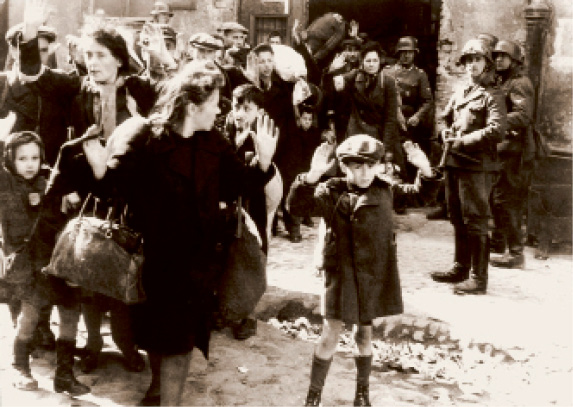Collaboration and Resistance
The ‘Final Solution’ was conceived and largely implemented by Nazis, but without collaboration on both macro and micro levels it could not have been so devastatingly executed.
France was unique among Nazi-occupied countries as the French government, operating from the spa town of Vichy between July 1940 and August 1944, instigated its own anti-Semitic policies. An influx of Jewish refugees fled to France in the 1930s and the Vichy leaders, under Philippe Pétain, had no qualms about the Nazis deporting non-French Jews. The Vélodrome d’Hiver round-up of 16–17 July 1942 is just one infamous instance of French complicity in the Holocaust: 12,884 foreign Jews were arrested by French police, then held in a Parisian cycling stadium for five days before being sent to camps at Beaune-la-Rolande and Pithiviers. Although three-quarters of France’s Jewish population survived the war, tens of thousands who did perish were initially rounded up by Frenchmen acting on orders from Vichy, not Berlin.
Civilians across Europe received payment for denouncing Jews to the Nazis, in some cases driven by personal anti-Semitism and in others by the hardships of war and desperate need for money. Escapees from the Sobibor uprising were tragically handed back to the SS by local farmers in return for food or alcohol. More direct involvement, such as the violent murders carried out by Einsatzgruppen squads, often stemmed from a very real sense of duty to the Third Reich. The racial propaganda machine and long-standing cultural tensions meant many who participated in such actions genuinely believed their cause was justified.
There were also cases of resistance against the Nazi persecution of minority groups. Many Jews went into hiding during the war, astutely realizing that to retain a visible presence in their community could be tantamount to suicide. The most famous case is that of Anne Frank and her family, who hid for twenty-five months in an Amsterdam warehouse before they were betrayed and deported. Both Jewish and non-Jewish resistance networks worked to find safe hiding places for Jews, purchased extra ration coupons on the black market and falsified ID cards by scratching away the ‘J’. Gentile citizens sheltered Jews in their homes and in many cases later suffered themselves for this act of humanity.
In spring 1944, thirty-two Jews from Palestine parachuted into Europe as members of the British Army, with the goal of rescuing other Jews (although their British leaders emphasized that this objective must be secondary to reconnaissance tasks and enabling the escape of captured Allied airmen). Hannah Szenes, a Hungarian Jew who had moved to Palestine in 1939, was one of these parachutists. After working with partisans in Yugoslavia, she attempted to cross the border into Hungary, but was captured and executed five months later, aged 23. While some of Hannah’s British Army comrades did succeed in assisting Jews, seven ultimately died for their cause.
Although Britain and America had condemned Nazi racial oppression in the 1930s and received reports of mass murder as early as 1941, they did little further to actively assist the Jews who remained in Europe, except permitting an annual quota of refugees to enter their countries. Anglo-American circles generally felt that stories of pit killings and gassings were implausible and believed the Jewish plight was less important than the overall Allied war effort.
One example of resistance on the macro level, however, is that of Denmark, whose citizens saved almost all its 8,000 Jews from deportation by shipping them to neutral Sweden in a covert operation. This was partly achieved thanks to the warning of a Nazi named Werner Best, who indirectly informed the Danish authorities of the impending round-ups. Another ‘good Nazi’ was Oskar Schindler, who saved over 1,000 Jews in Poland by employing them in his factory. Whether motivated by greed or racism, humanity or pity, the actions of one person could mean the difference between life and death for those who were hunted by the Nazis.
The most momentous example of collective Jewish resistance during the Holocaust was the Warsaw ghetto uprising in 1943. Following mass deportations throughout the summer of 1942, members of numerous self-defence groups and political factions who remained in the ghetto determined to resist future deportations. They successfully attacked the SS in January 1943, forcing the Nazis to withdraw on this occasion; however, Himmler subsequently ordered the complete destruction of the ghetto.
On 19 April 1943, SS forces closed in to commence liquidation of the Warsaw ghetto. Since January, the resistant ghetto factions had amassed weapons through links with the Polish underground movement. They had also dug bunkers, where many Jews now took shelter. The SS found the ghetto streets largely deserted, until 750 Jews who were not in hiding attacked the soldiers with pistols, hand grenades and homemade explosives. After several days of violent fighting the SS set fire to the ghetto and as Jews were forced from their hiding places, they were rounded up and subsequently deported to extermination and concentration camps.

Jews being arrested during the Warsaw ghetto uprising, 1943
The Nazis had aimed to empty the ghetto within three days but incredibly, the resisters held out for nearly a month, until 16 May 1943. All buildings had been razed to the ground, effectively obliterating what had once been Warsaw’s thriving Jewish quarter. Over 7,000 Jews lost their lives in the uprising, compared to an estimated 300 Nazi soldiers. While a few Jews avoided deportation by escaping through the sewers, of the thousands who were captured and deported only a minority survived the war.